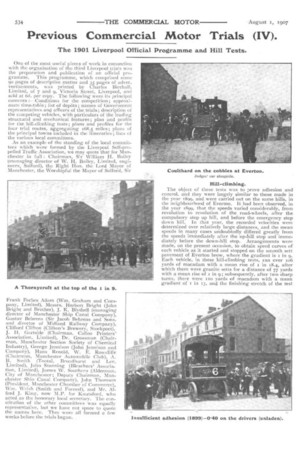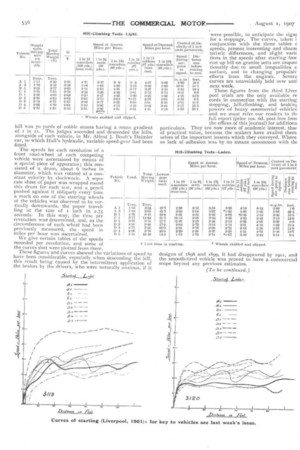Previous Commercial Motor Trials (IV).
Page 22

Page 24

If you've noticed an error in this article please click here to report it so we can fix it.
The 1901 Liverpool Official Programme and Hill Tests.
One of the most useful pieces of work in connection with the organisation of the third Liverpeol trials was the preparation and publication of an official programme. This programme, which comprised some 90 pages of descriptive matter and 35 pages of adver_ vertis.ements, was printed by Charles Birchall, Limited, of 7 and 9, Victoria Street, Liverpool, and sold at 6d. per copy. The following were its principal contents :—Conditions for the competition; approximate time-table; list of depots; names of Government representatives-and officers of the trials; description of the competing vehicles, with particulars of the leading structural and mechanical features; plan and profile for the hill-climbing tests; plans and profiles for the four trial routes, aggregating 168.5 miles; plans of the principal towns included in. the itineraries ; lists of the various local committees.
As an example of the standing of the local committees which were formed by the Liverpool Self-propelled Traffic Association, we may quote that for Manchester in full : Chairman, Sir William H. Bailey (managing director of W. H. Bailey, Limited, engineers, Salford), the Right Hon. the Lord Mayor of Manchester, the Worshipful the Mayor of Salford, Sir
Frank Forbes Adam (Wm. Graham and Company, Limited), Messrs. Herbert Bright (John Bright and Brother), J. K. Blythell (managing director of Manchester Ship Canal Company), Gustav Behrens (Sir Jacob Behrens and Sons, and director of Midland Railway Company), Clifford Clifton (Clifton's Brewery, Stockport), J. H. Gartside (Chairman, Calico Printers' Association, Limited), Dr. Grossman (Chairman, Manchester Section Society of Chemical Industry), George Jennison (John Jennison and Company), Hans Renold, W. F. Rowcliffe (Chairman, Manchester Automobile Club), A. B. Smith (Tootal, Broadhurst and Lee, Limited), John Swirling (Bleachers' Association, Limited), James W. Southern (Alderman, Cityof Manchester ; Deputy Chairman, Manchester Ship Canal Company), John Thomson (President, Manchester Chamber of Commerce), Wrn. Welsh (Smith and Forrest), and Mr. Alfred J. King, now M.P. for Knutsford, who acted as the honorary local secretary. The constitution of the other committees was equally representative, but we have not space to quote the names here. They were all formed a few weeks before the trials began. . Hill-climbing.
The object of these tests was to prove adhesion and control, and they were largely similar to those made in the year 1899, and were carried out on the same hills, in the neighbourhood of Everton. It had been obServed, in the year 1899, that the speeds varied considerably, from revolution to revolution of the road-wheels, after the compulsory stop up hill, and before the emergency stop down hill. In that year, the recorded velocities were determined over relatively large distances, and the mean speeds in many cases undoubtedly differed greatly from the speeds immediately after the up-hill stop and immediately before the down-hill stop. Arrangements were made, on the present occasion, to obtain speed curves of each vehicle as it started and stopped on the smooth sett pavement of Everton brow, where the gradient is I in 9. Each vehicle, in these hill-climbing tests, ran over to6 yards of macadam with a mean rise of i in 18.4, after which there were granite seits for a distance of 77 yards with a mean rise of i in 9; subsequently, after two sharp turns, there were no yards of macadam with a mean gradient of i in 13, and the finishing stretch of the test car, to which Hall's hydraulic, variable speed-gear had been of in 11. The judges ascended and descended the hills, fitted. .
hill was 70 yards of cobble stones having a mean gradient alongside of each vehicle, in Mr. Alfred J. Boult's Daimler
car, to which Hall's hydraulic, variable speed-gear had been of in 11. The judges ascended and descended the hills, fitted. .
hill was 70 yards of cobble stones having a mean gradient alongside of each vehicle, in Mr. Alfred J. Boult's Daimler
The speeds for each revolution of a front road-wheel of each competing vehicle were ascertained by means of a special piece of apparatus; this consisted of a drum, about 6 inches in
diameter, which was rotated at a conTotal
Vehicle Load. Moving
stant velocity by clockwork. A sepaNo. Weight. rate sheet of paper was wrapped round this drum for each test, and a pencil pushed against it obliquely every time a mark on one of the steering wheels of the vehicles was observed to be vertically downwards, the paper travelling at the rate of z inch in 2.75 seconds. In this way, the time per revolution was; determined, and, as the circumference of each wheel had been previously measured, the speed in miles per hour was ascertained.
We give certain tables of the speeds recorded per revolution, and some of the curves that were plotted from them.
These figures and curves showed the variations of speed to have been cons-iderable, especially when descending the hill, this result being caused by the intermittent application of the brakes by the drivers, who were naturally anxious, if it
Al A2 B' Cl Dl DO D 354 355
Tons. 1-53 153 4-76 6-77 3.75 4-91 4-75 4-86 5.51 Tons. 3-63 3'65 8-41 14.02 8-75 9-16 S1-25 9-78 10.40
were possible, Lo anticipate the signi for a stoppage. The curves, taken i conjunction with the three tables c speeds, present interesting and chara( teristic differences, and slight variz tions in the speeds after starting fror rest up hill on granite setts are unques tionably due to small inequalities ct surface, and to changing propulsiv efforts from the engines. Severa curves are unavoidably held over unti next week.
These figures from the third Liver pool trials are the only available re cords in connection with the starting stopping, hill-climbing, and brakiN powers of heavy commercial vehicles and we must refer our readers to Eh) full report (price Ins. 6d. post free fron the offices of this journal) for additiona particulars. They are now more of academic interest, that of practical value, because the makers have availed themselves of the important lessons which they conveyed. Whereas lack of adhesion was by no means uncommon with th(
4-14 4-80 2-85 3-58 3-44 4-10
m.p. hr• 6-60 10-81 5.31 2-51 4-21 358 2.75 5-17 5-33 feet. 16-5 51'1 19-4 8-6 149 8-5 11-2 15 5 25.1
designs of 1898 and 1899, it had disappeared by /9o1, and the smooth-tired vehicle was proved to have a commercial scope beyond any previous estimates.


























